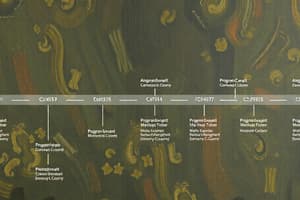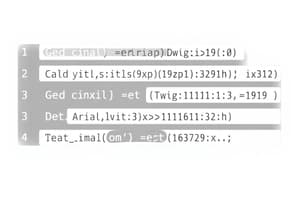Podcast
Questions and Answers
What does the algorithm for comparing numbers output if A is greater than the rest?
What does the algorithm for comparing numbers output if A is greater than the rest?
A flowchart is a sequence of instructions written in a programming language.
A flowchart is a sequence of instructions written in a programming language.
False (B)
What is the formula for calculating the area of a circle given its radius r?
What is the formula for calculating the area of a circle given its radius r?
Area = 3.14 * r * r
In pseudo code, the term used for incrementing a value is _____ .
In pseudo code, the term used for incrementing a value is _____ .
Signup and view all the answers
Match the following pseudo code terms with their actions:
Match the following pseudo code terms with their actions:
Signup and view all the answers
What type of documentation is primarily intended for other programmers?
What type of documentation is primarily intended for other programmers?
Signup and view all the answers
An algorithm must always include a user manual.
An algorithm must always include a user manual.
Signup and view all the answers
What is the first step in the algorithm to find the area of a circle?
What is the first step in the algorithm to find the area of a circle?
Signup and view all the answers
The algorithm to find the greatest among three numbers compares ______ and ______ first.
The algorithm to find the greatest among three numbers compares ______ and ______ first.
Signup and view all the answers
Match the algorithm types to their control structures:
Match the algorithm types to their control structures:
Signup and view all the answers
What is the expected output from the algorithm that calculates the area of a circle?
What is the expected output from the algorithm that calculates the area of a circle?
Signup and view all the answers
An algorithm can contain ambiguous instructions.
An algorithm can contain ambiguous instructions.
Signup and view all the answers
What does the variable 'MAX' represent in the algorithm to find the greatest among three numbers?
What does the variable 'MAX' represent in the algorithm to find the greatest among three numbers?
Signup and view all the answers
Which phase comes immediately after planning in the software development life cycle?
Which phase comes immediately after planning in the software development life cycle?
Signup and view all the answers
The retirement phase is an official part of the software development life cycle.
The retirement phase is an official part of the software development life cycle.
Signup and view all the answers
What is the purpose of the implementation phase in the software development life cycle?
What is the purpose of the implementation phase in the software development life cycle?
Signup and view all the answers
The program development life cycle starts again at Step 1 after __________ and maintenance.
The program development life cycle starts again at Step 1 after __________ and maintenance.
Signup and view all the answers
Match the following phases of the software development life cycle with their main activities:
Match the following phases of the software development life cycle with their main activities:
Signup and view all the answers
Which tool is NOT mentioned as a method for developing a detailed logic plan during the design phase?
Which tool is NOT mentioned as a method for developing a detailed logic plan during the design phase?
Signup and view all the answers
Internal documentation refers to comments and remarks in the code explaining its purpose.
Internal documentation refers to comments and remarks in the code explaining its purpose.
Signup and view all the answers
What is the main focus of the testing and integration phase?
What is the main focus of the testing and integration phase?
Signup and view all the answers
Study Notes
Introduction to Computer Systems - Module 5: Algorithm Development
- Objectives: Recognize the program development life cycle, select appropriate computer-based methods for modeling and analyzing problems, and differentiate between algorithm, pseudocode, and flowchart.
Software Development Life Cycle (SDLC)
-
Planning (Problem Definition): Defines the problem statement and problem boundaries. This phase involves understanding the requirements, desired output, and the solution.
-
Problem Analysis: Precisely defines the problem to be solved and details program specifications, including inputs, processing, outputs, and user interface.
-
Design: Develops a detailed logic plan using tools like pseudocode, flowcharts, or object structure diagrams to identify modules, algorithms, and solutions for each module.
-
Implementation: Translates the design into an application using a programming language or development tool, creating a user interface, and writing code that includes internal documentation and remarks explaining the logic of the code.
-
Testing and Integration: Tests the program, identifying and correcting errors (debugging) to ensure an error-free program that meets desired results.
-
Maintenance: Provides education and support to end-users, corrects unanticipated errors, and handles user requests for modifications or enhancements. If changes are implemented, the SDLC begins again.
-
Retirement: The program/application is no longer needed and/or is outdated; usually, its code or an entire replacement application is created.
Documentation
-
Documentation: Includes materials generated during the SDLC process, covering flowcharts, messages, algorithms, code, and user manuals, and internal and external documentation.
- Internal: Used by programmers to understand the logic and the way the program was designed.
- External: Consists of user manuals, FAQs, and help sections.
Algorithm
- Definition: An ordered sequence of finite, well-defined, and unambiguous instructions for completing a task.
- Origin: The term "Algorithm" derives from the name Muhammad ibn Musa al-Khwarizmi.
Algorithm (Example) - Finding the area of a circle
- Problem: Calculate the area of a circle with radius 'r'.
- Input: Radius 'r' of the circle.
- Output: Area of the circle.
- Algorithm:
- Read/input radius 'r'.
- Compute Area = 3.14 * r * r.
- Print Area.
Algorithm (Example) - Finding the greatest among three numbers
-
Algorithm 1:
-
Read numbers A, B, and C.
-
Compare A & B. If A is greater, go to step 3; otherwise, go to step 4.
-
Compare A & C. If A is greater, output 'A is greatest'; otherwise, output 'C is greatest'.
-
Compare B & C. If B is greater, output 'B is greatest'; otherwise, output 'C is greatest'.
-
Algorithm 2:
-
Read A, B, and C
-
Compare A & B. If A is greater, store 'A' in MAX; else store 'B' in MAX.
-
Compare MAX & C. If MAX is greater, output 'MAX is greatest'; otherwise, output 'C is greatest'.
Algorithm (Control Structure) - Sequential
- The instructions are executed in a linear, one-by-one order.
Algorithm (Control Structure) - Selection
- Asks a true/false question; the next instruction is chosen based on the true/false answer. This selects the specific set of instructions to execute based on a given condition. Example provided of the comparison of three numbers.
Algorithm (Control Structure) - Iterative/Looping
- The execution of a block of instructions is repeated. An Example (provided) of finding the sum of the first 100 integers is included.
Flowchart
- Definition: A diagrammatic representation of the logic for solving a task—a visual representation of an algorithm.
- Symbols: Specific symbols represent various actions (e.g., start/end, processing, input/output, decision).
Flowchart (Example) – Product of two numbers
- Step 1: Start.
- Step 2: Read 'A' and 'B'.
- Step 3: 'C' = A * B
- Step 4: Print 'C'
- Step 5: Stop
Flowchart (Example) – Finding the maximum of three numbers
- Step 1: Start.
- Step 2: Read 'A', 'B', and 'C'.
- Step 3: If A > B, then MAX = A; else MAX = B.
- Step 4: If MAX > C, then print 'MAX'; else print 'C'.
- Step 5: Stop
Flowchart (Example) – Sum of first 100 integers
- Step 1: Start.
- Step 2: SUM = 0. I = 0.
- Step 3: I = I + 1. SUM = SUM + I.
- Step 4: If I >= 100, then print SUM; else go to step 3.
- Step 5: Stop.
Pseudocode
- Definition: A short, readable, and formally styled English representation of an algorithm. This is often used to outline a possible algorithm.
- Terms: Uses specific terms for actions, like "input," "output, "increment," initialization," and 'computation.'
Pseudocode (Example)- Finding the product of two numbers
- Step 1: READ values of 'A' and 'B'.
- Step 2: COMPUTE C by multiplying A with B.
-
Step 3: PRINT result
C. - Step 4: STOP.
Pseudocode (Example)- Sum of first 100 integers
-
Step 1: INITIALIZE
SUMto zero. -
Step 2: INITIALIZE
Ito zero. -
Step 3: DO WHILE (
Iis less than 100) -
Step 4: INCREMENT
I -
Step 5: ADD
ItoSUMand store in SUM - Step 6: PRINT SUM
- Step 7: STOP.
Pseudocode (Example) – Maximum of three values
- Step 1: READ values of 'A,' 'B,' and 'C.'
- Step 2: IF 'A' is greater than 'B' THEN assign A to MAX.
- Step 3: ELSE assign 'B' to 'MAX'.
- Step 4: IF 'MAX' is greater than 'C' THEN print 'MAX is greatest' ELSE print 'C is greatest'.
- Step 5: STOP.
Studying That Suits You
Use AI to generate personalized quizzes and flashcards to suit your learning preferences.
Related Documents
Description
Explore the essentials of algorithm development in computer systems. This module covers the program development life cycle, software development processes, and distinctions among algorithms, pseudocode, and flowcharts. Enhance your understanding of problem analysis and design methodologies.





